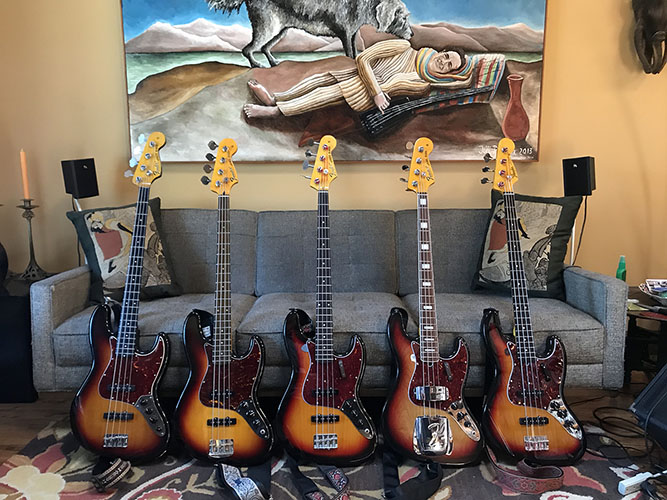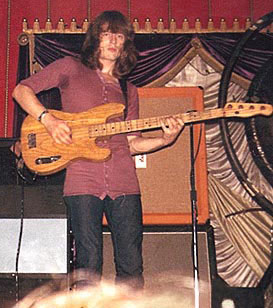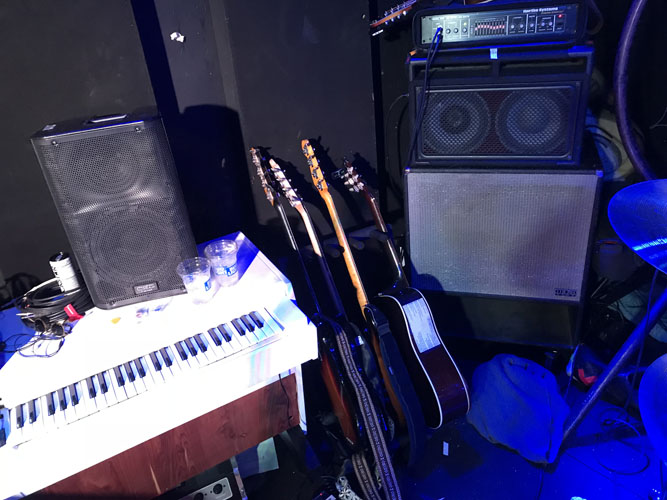

Basses and Bass Gear
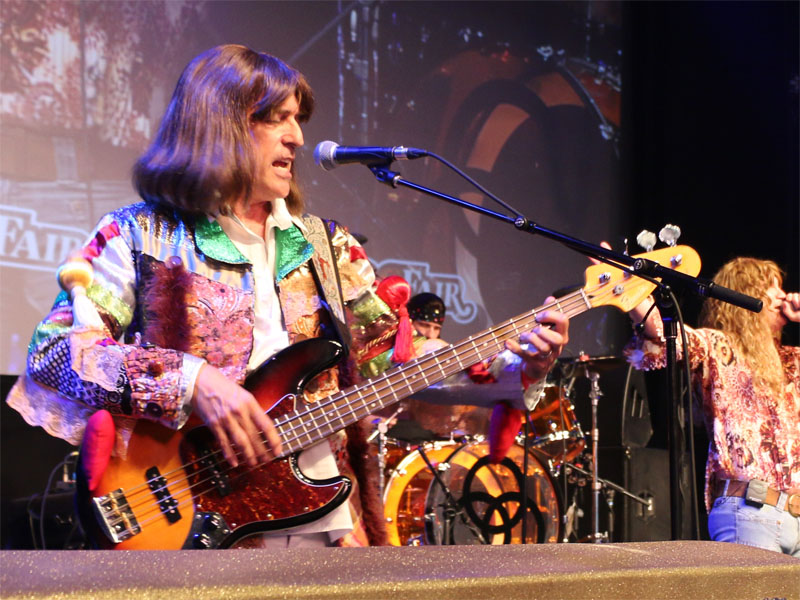
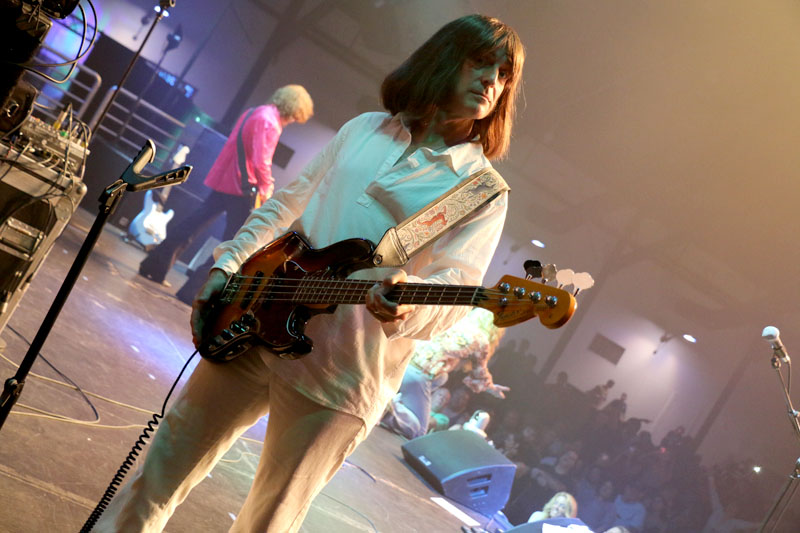
Performing NOBODIES FAULT and ACHILLES LAST STAND with the 8-string bass.
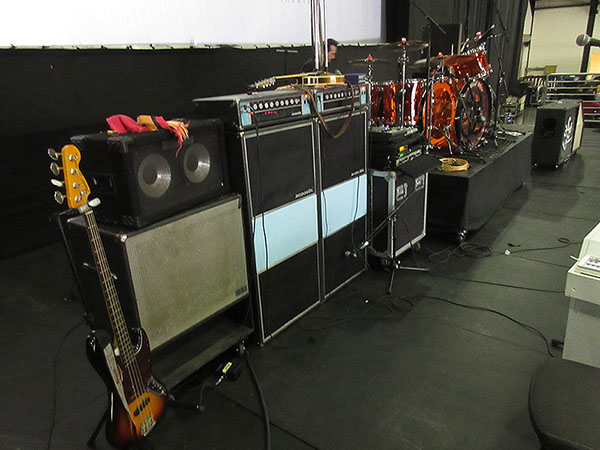
Performing BRON-Y-AUR STOMP with electric upright bass.Latest 2020 Bass Projects:
Five Sunburst Jazz Basses
I've now built 5 of these things (4 '62ish JPJ-type basses, and one fully dressed '67-style Jazz Bass just because it's pretty). I may have gotten the builds out of my system, and have plenty of options to choose from depending on the Zeppelin era/songs being performed (and almost ANY other music as well - imagine that). I really don't think I need any more (or even all of these, whatever), but time will tell. Once we live musicians return to our trade, I'll figure out which one or ones become my new favorite(s). What a luxury of choices!
#5 JPJ Tribute Sunburst Jazz Bass
In 1964 John Paul Jones purchased a 1962 Fender Sunburst Jazz Bass from a London music shop for around $400, and that was his main bass for recording and performing until he kinda wore it out around 1975 (when he switched to Alembics for the remaining years of Zeppelin). This is my recently completed (June 2020) #5 Sunburst Jazz, attempting to get even closer to his iconic '62 in look and tone. It's quite the instrument.
'51 Precision Bass
In the first days of January 2020 I completed building a recreation of JPJ's '51 Precision Bass. The story goes that, at a live show around 1971, a bass seller turned up in the dressing room with a very early Fender P Bass that had been painted ENTIRELY (including the neck) the color purple. Jones still felt there was a good bass under there, so he bought it and gave it to someone to strip all the paint off and restore it to playable condition. Although I kinda prefer the pickguard I placed on it to properly position the control plate, his restored and rather naked-looking bass had an edgier growl than his Jazz Bass, and can be heard on live recordings during that era (and perhaps on some studio cuts as well...?). A video performing WANTON SONG with this bass is on the home and video page.
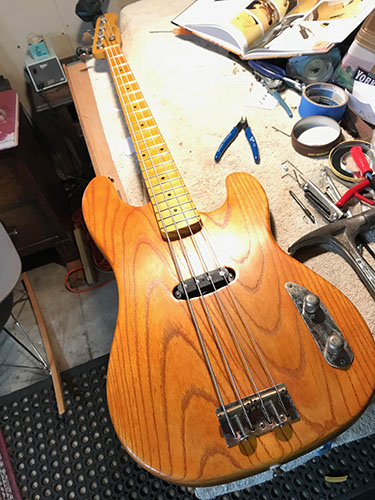

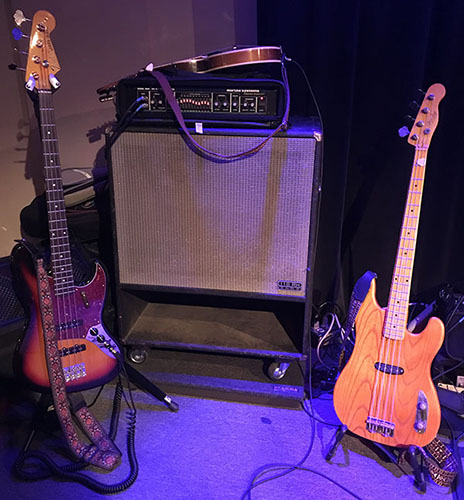
2019 Bass Projects:
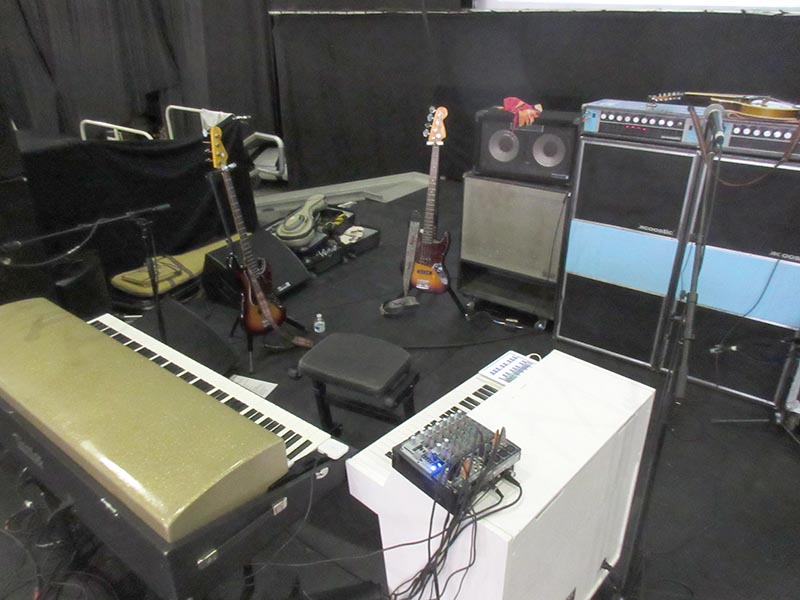
John Paul Jones famously toured from about 1969 until the mid/late 1970's with very recognizable big bass cabinets with the light blue band down the middle - the Acoustic 360/361 bass rig, consisting of one or two of the Acoustic 360 bass preamps, and a pair on 361 rear-loaded folded 18" speaker cabinets. They were famously clean and loud, and notoriously large and heavy. I have been very happy now for almost 30 years with my Hartke biamped bass head (and even have an identical backup for a second rig), and much prefer today's front-loaded speaker cabinets that sound big and warm to me right there on stage, instead of only 20-50 feet away in large concert halls - which is what the Acoustic bass cabinet was also notorious for (I owned one briefly, and was very annoyed by its size and lack of low end from where I was playing). But in order to LOOK right, I need these big black and blue beasts building a wall behind me, so...
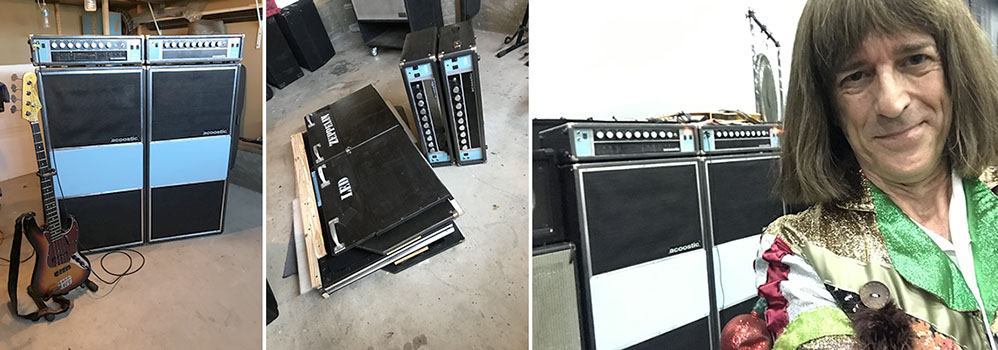
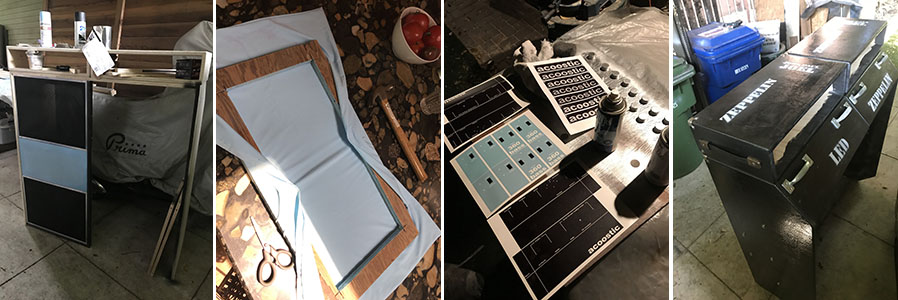
My acoustic360bass rig consists of a pair of cabinets that disassemble (with the aid of a screw gun) and fold flat to load on the roof of my car. Inside them is nothing, unless I stow my bass cabinets behind/inside (my first big gig with them found them rattling too much, so my real bass rig was set up next to it). On top are a pair of empty 360 bass heads, with very detailed waterslide decals on the face, and spray painted knobs (the trickiest part - I would have preferred finding or making real metal/aluminum knobs, but they proved impossible to find and expensive to have made, plus they would have taken too long, and the painted ones read fine from 10 feet away). One of the heads is wired so the input jacks get wired directly into my Hartke head, which is mounted inside and accessible from the front behind a "curtain" (and both have LED power lights). They even feature almost exact duplicate white stencil LED ZEPPELIN lettering as seen on JPJ's actual rig from photos I found online (almost, because mine do say JOHN PAUL JOEL). That they weight very little and fold up to take up very little space means they are actually practical and useable almost anywhere.
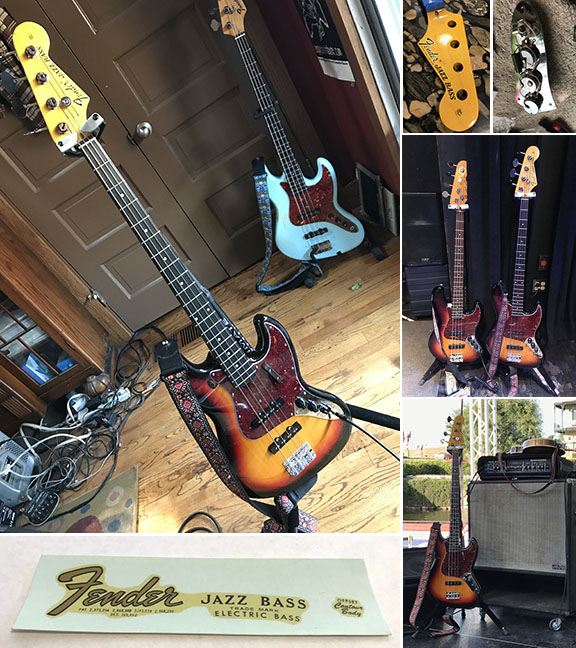
My #1 Sunburst Jazz Bass is quite awesome - extremely easy to play and resonant (there's a magic between the neck and body). Assembled from (I think, trying to remember) a Fender Mexi Sunburst Jass Bass body, a terrifically thin Mighty Mite Jazz Neck (one of the oldest necks I've owned, having graced at least 1 if not 2 other basses before this one), Fender Custom Shop Vintage 60's pickups and D'Addario Half Round strings (a bit of edge, but very smooth feel). But (of course) nothing is ever good enough, and all of the recent work with Jimmy Sakurai has inspired me to go even deeper into the vintage-correct instrument thing, so...
I got a very cheap Chinese neck off of Amazon and really worked it over, including sanding, fretwork, amber staining and oil finishing. For the decal, instead of my custom Funster label, I chose to use the last of my Fender Jazz Bass decals (although, instead of "Offset Contour Body" I created a "John Paul Joel" text decal to personalize it just a bit). After all the work sealing and sanding to get them flat, I realize that it's the WRONG era Fender logo (70's instead of 60's), and will probably redo the headstock if and when I finish this thing.
For the body, I thought I would try out an ultra-light version of Fender's traditional sunburst Jazz Bass (being my 3rd ultrlight, after a TV Yellow '61 style Jazz that plays and sounds great, and a relic'd Daphne Blue '63 Jazz I recelntly completed that plays great, but is slightly lacking low end). With ultra-light Gotoh vintage-correct tuners, another set of Fender Vintage 60's pickups, and all the correct electronics, caps, etc, this bass was a delight to hold and play at under 7lbs total, but NO LOW END - it's like everything under the low A disappeared. Two more sets of pickups later (including a set of Dimarzio Hot Vintage Jazz pickups) did not solve the problem, so I reluctantly gave up on the lightweight body, sourced a great Ash sunburst one, and - voila: Fantastic thumpy tone with LaBella flats, which are a bit harder on the right hand when sticky with sweat, but (for now) my new #1.
The head is slightly smaller than stock Jazz bass heads, and it still needs to be refinished for the correct decal, so the project continues. I'm even sourcing a couple more custom made, vintage-correct necks (with heel truss rod adjustment) to swap the neck out one more time, and have one more sunburst body to make a 3rd version, this one with Rotosound roundwounds, in order to have all the possible sonic flavors.
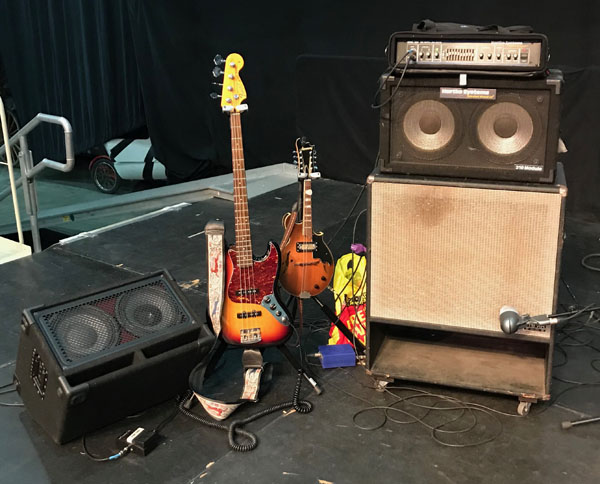
My 2018 bassrig: Hartke 2500 bass amplifier, bi-amped to an 1980's era MusicMan 18" (loaded with an amazing Gauss driver) and Ampeg 2x10 speaker cabinets. The extra instruments in the second photo include a Gibson acoustic guitar and a fretless Precision-style bass.Some classic tributes pride themselves on using the correct "vintage" gear for their band, but vintage gear, including instruments (which can be substandard, or too valuable to bring out of the house or vault) and amplification (which can be unreliable and heavy) is not necessarily the best way to make this music today. I beleive that it needs to look correct, but why sacrifice playability or sound quality? What is important to me, besides looks, is that the gear is versatile, portable and very reliable. This is theater after all, not just a music gig, even performace art if taken to the highest level, and part of the fun of a tribute (for me) is the process of putting together the right combination of instruments and equipment so that I can comfortably make the music, while looking the part.
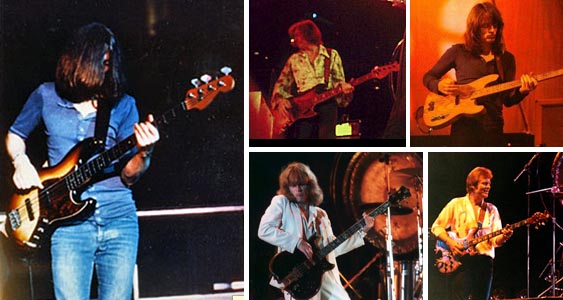
Some of JPJ's basses, including his "62 Jazz (left), and (clockwise) Fender IV, Fender '51 Precision (also caled a Tele), Alembic 4 string (from 1975 on) and Alembic Triple Omega 8-stringJohn Paul Jones main and most recognizable bass was a '62 Fender Jazz bass in sunburst finish with a tortoise pickguard. He used this bass for recording and touring with Zep until the mid/late 1970's, when he started using Alembics. His other basses included a Fender IV 6-string bass, a Fender '51-style Tele/Precision bass with the finish sanded off (used live for Blackdog and perhaps a few other tunes), a fretless Fender Precision bass (for for In My Time of Dying), a Hagrstom 8 string (used to record Achilles Last Stand and Nobody's Fault) and a beautiful custom Triple Omega 8-string Alembic bass (for playing those 2 songs live - this bass probably cost more than my car).
The obvious bass that all JPJ tribute musicians play in the Fender Jazz bass. Most of my life I have either assembled my basses from parts sourced from all over, or made some of the parts (bodies or necks) myself from scratch. One of my first basses, the one I used through my college days, featured a home-walnut body with a Fender Jazz neck. I LOVED that neck - nice and thin, played fast with low action (I have no idea where that bass might be today, 30 years later). Just out of college I played, fell in love with, took out my forst loan and purchased a Steinberger L2 bass, and remained faithful to this bass for over 20 years. I did have a couple of others (5 string, fretless and electric upright), but the L2 was a solid and comfortable old shoe that never let me down (until I started doing tributes in the mid-2000's and needed some wood basses for the correct look and sound).
My first Zeppelin bass: Knowing I would need a sunburst Jazz bass for JPJ, I toyed with the idea of just buying an actual Fender (probably a Japanese reissue), but that's really not my style... There was this Moses graphite jazz neck lying around that I had for over 15 years, and I thought I might try it out. It was just too dead on a Jazz bass I assembled years ago, but I threw it on a different body for the HEARTBREAKER auditions and found that it sounded totally different (and BETTER!), so I thought I would give it one more chance. I superglued maple veneer to the front and back of the headstock, did a classic amber tint and applied a Fender sticker and some clear gloss, and - voila - a gorgeous "vintage" looking Jazz neck with the superior qualities of graphite (including tuning stability, weight and sustain).
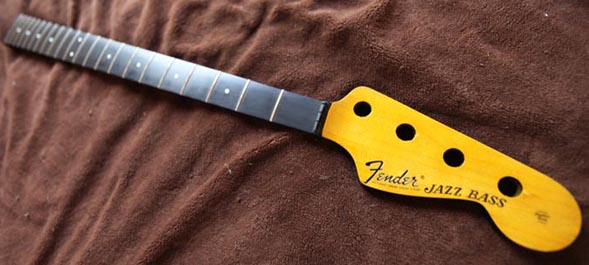
My completed "vintage" Fender Moses raphite neck. Yes, it's a mid-late 60's style decal (not the correct early 60's one), but I prefer how it looks, and it's more visible from a distance.Although I am also a big fan of EMG pickups and electronics, I was impressed with the active electronics on current US Fender Deluxe Jazz basses, so I tracked down a set of Fender Deluxe Jazz pickups with the active electronics, a Fender Deluxe bridge (which looks pretty much like the classic bridge, but is heavier for more sustain), and a Mexi Jazz sunburst body (I already had a great lightweight set of classic Fender-style Grover tuning machines which I pulled off of another bass). Major surgery consisted of quite a bit of routing (to fit the active electonics and two batteries), two days of soldering until everything worked corectly, add a tortiose pickguard and a "thumb rest" (which is useless, but correct for the bass), and a "vintage" looking but very modern hybrid bass. I own, have built and have played many basses, and I have to say this is a truly outstanding instrument to play and to oogle! Note: In 2016 I put roundwounds on this bass, and have brought it out for a couple of gigs, but my lighter Funster Jazz with the Mighty Mite neck has become my default JPJ bass.
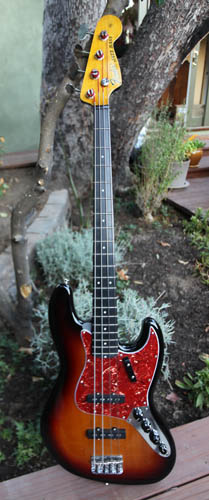
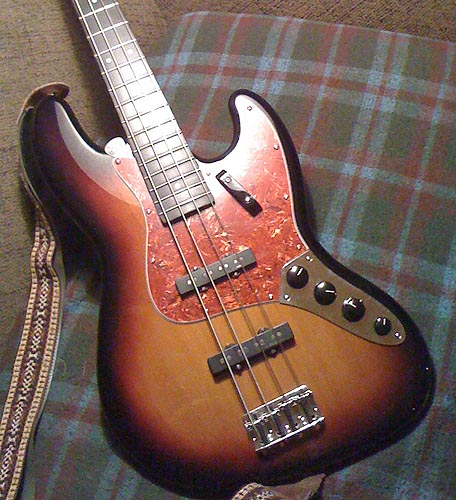
The finsihed "vintage" Fender Jazz bass (note correct vintage Gibson strap), with active electronics (to roll in or out the mids), La Bella flatwounds (for that smooth bottomy sound), a modern graphite neck and hybrid steel/aluminum tuners. Very important to the sound and the ease of playability was the addition of a set of La Bella flatwounds. I love these strings, and believe they are the finest flats out there - they feel soft, not stiff, and have a great sound and long life (this is a good thing, considering the price). Almost all my basses are strung with Rotosound roundwounds, and I beleive JPJ used these as well, but he got a very warm flat sound out of his bass, partly due to the use of his Acoustic 361 bass amp/speaker combo with a single 18" - not the modern bi-amped (or more) hi-fi sound.

My 2015-present bass rig continues to miniaturize without compromise. The Hartke amp now powers an all-original MusicMan 118 18" cabinet (which sounds fuller than even two of the Hartke 18's) and an amazing slant-back Ampeg 2x10 cabinet. My go-to Jazz bass is now a lighter, all-passive Funster Joel bass with Fender Custom Shop Vintage pickups and a super thin Mighty Mite neck, topped off with Dunlap Half-Round strings (pictured at the top of this page). For gigs providing a backline, most venues just set up an Ampeg SVT head and 8x10 cab (or a double stack), which I used to hate for other gigs, but find perfectly aceptable for the JPJ Zep bass sound (one head and two cabinets are optimal, and needed to generate the same amount of low end as the single 18" MusicMan cab).

As of August 2019 my rig also includes the acoostic360bass faux-cabinets and amp heads, for that truly authentic wall of hardware behind me (space permitting). Look, it's even miked!JPJ also used an 8 string bass on a few songs from the Presence album, and ZEPPELIN LIVE regularly performs a slightly abbreviated version of Achilles in their sets. I could not possibly afford an Alembic Triple Omega 8-string (although I am currently building one), but Hagstrom reissued their 8-string bass, and I have added one to my rig when the gigs are local/driving distance (for flying gigs, I generally only take the Fender). It sounds great for this song (as well as NOBODIES FAULT, which I rarely get to play live).
Future additions? Now that the Acoustic 360 rig is covered, there's only a 3 more basses. JPJ had a sanded-down early Precision bass, and I have all the parts EXCEPT the body, which I am going to cut myself once I can get the lumber I picked out planed to the proper thickness. In the mid-1970's JPJ switched to a 4-string Alembic Series One, along with the BecVar (Alembic-style) 8-string, and I have begun building those from scratch with a tentative completion for the end of late 2019 or 2020. And he did tour a couple of years with a rare 5-String Fender bass, and there's even one in a shop here in Studio City, but he didn't care for it and it's too expensive to consider, so I'll probably pass on it.
For now.
© 2011-20 Joel Pelletier, email: joelp@johnpauljoel.com
Updated 30 July 2020Joel, Pelletier, joelpelletier, joelp, independent, indie, Los Angeles, chamberpop, chamber pop, chpop, realtime, (real)time, real, time, mp3, free, audio, video, CD, CD-ROM, DVD, enhanced, album, project, rock, pop, songs, music, lyrics, classical, acoustic, electric, hybrid, genre, art, artist, multimedia, painter, composer, arranger, producer, musician, multi-instrumentalist, solo, band, bass, double bass, guitar, drums, piano, cello, violin, viola, orchestra, quartet, string, arrangement, orchestration, studio, live, perform, tour, america, europe, asia, free, buy, donate, donation, download, mp3, digital, analog, surround, 5.1, QuickTime, animation, illustrations, images, media, Real, steinberger, NAMM, EAW, mackie, way home, web designer, Beethoven, Stravinsky, Bartok, Berg, Hindemith, John Lennon, Beatles, Crowded House, George Martin, Peter Gabriel, Sting, XTC, Paul Simon, Joe Jackson, translations, american, english, french, spanish, portuguese, german, italian, russian, swedish, chinese



